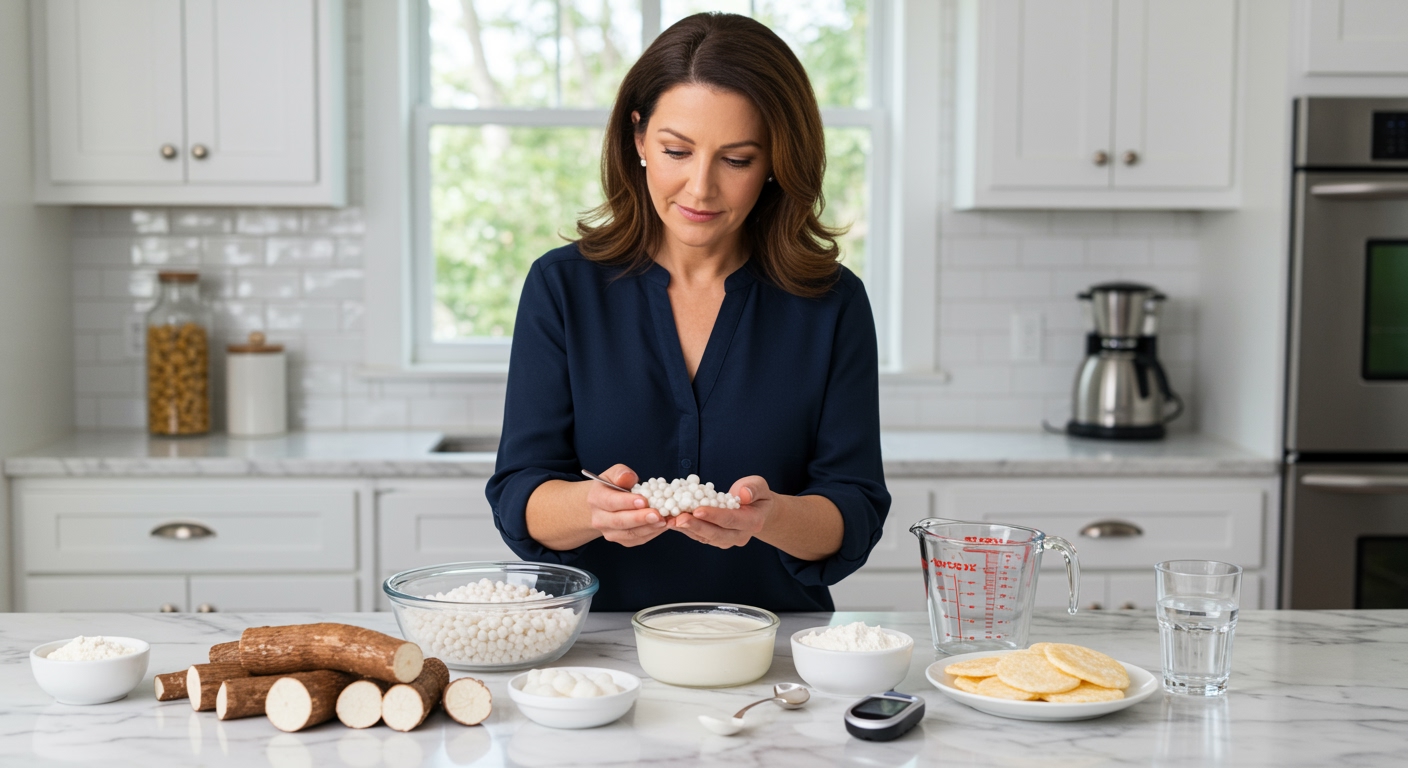✪ Key Takeaway: Tapioca has a high glycemic index and can spike blood sugar quickly, making it risky for diabetes management.
Introduction
You walk down the grocery aisle and see tapioca pudding, tapioca flour, and bubble tea with those chewy tapioca pearls.
You might wonder if this popular starch is safe for your blood sugar levels, especially if you have diabetes or prediabetes.
Hi, I am Abdur, your nutrition coach and today I am going to explain everything you need to know about tapioca and its effects on blood sugar control.
What Exactly Is Tapioca And How Does It Affect Blood Sugar?
Tapioca comes from the cassava root, a starchy vegetable grown in tropical regions around the world.
The cassava root gets processed into different forms like tapioca flour, tapioca starch, and those familiar tapioca pearls you see in desserts.
When you eat tapioca, your digestive system breaks down its complex carbohydrates into simple sugars very quickly.
This rapid breakdown means glucose enters your bloodstream fast, causing your blood sugar levels to rise sharply.
Tapioca has a glycemic index of around 70 to 85, which puts it in the high category for blood sugar impact.
Foods with high glycemic index values cause rapid spikes in blood glucose, making them challenging for people with diabetes to manage.
✪ Fact: Pure tapioca starch contains almost no protein, fat, or fiber to slow down glucose absorption.
Does Tapioca Provide Any Nutritional Benefits For Diabetics?
Tapioca offers very limited nutritional value beyond its carbohydrate content.
One cup of tapioca pearls contains about 135 calories and 34 grams of carbohydrates with less than 1 gram of protein.
The lack of dietary fiber in processed tapioca means it provides no help with blood sugar control or digestive health.
Tapioca does contain small amounts of iron and calcium, but these minerals are present in much higher quantities in other foods.
For people with diabetes, foods should provide sustained energy without causing dramatic blood sugar fluctuations.
Unfortunately, tapioca fails this test because it acts more like pure sugar than a complex carbohydrate.
The empty calories from tapioca can also contribute to weight gain, which makes diabetes management more difficult over time.
✪ Note: Raw cassava root contains more nutrients than processed tapioca products.
How Much Tapioca Can Diabetics Safely Consume?
The safest approach for people with diabetes is to limit tapioca consumption significantly or avoid it completely.
If you choose to include tapioca in your diet, portion control becomes absolutely critical for blood sugar management.
A small serving of about 2 tablespoons of cooked tapioca pearls contains roughly 15 grams of carbohydrates.
This amount equals one carbohydrate exchange in diabetes meal planning, which means it should be counted toward your total daily carb intake.
Always pair tapioca with protein and healthy fats to help slow down glucose absorption into your bloodstream.
Monitor your blood sugar levels closely after eating tapioca to understand how your body responds to this high-glycemic food.
Consider timing tapioca consumption around physical activity when your muscles can use the quick glucose more effectively.
✪ Pro Tip: Test your blood sugar 2 hours after eating tapioca to track its impact on your levels.
What Are Better Alternatives To Tapioca For Diabetics?
Several diabetes-friendly alternatives can satisfy your craving for chewy textures without spiking blood sugar.
Shirataki noodles made from konjac root contain virtually no carbohydrates and provide a similar chewy texture to tapioca pearls.
Chia seeds soaked in liquid create a pudding-like consistency while providing fiber, protein, and healthy omega-3 fatty acids.
For baking applications, almond flour or coconut flour work better than tapioca starch because they contain protein and fiber.
Steel-cut oats offer a chewy texture with complex carbohydrates that digest more slowly than tapioca.
Greek yogurt with berries provides creamy satisfaction without the blood sugar roller coaster that tapioca creates.
These alternatives not only help maintain stable blood sugar but also provide essential nutrients that support overall health.
✪ Fact: Shirataki noodles contain only 5 calories per serving compared to 135 calories in tapioca pearls.
The Bottom Line
Tapioca poses significant challenges for blood sugar control due to its high glycemic index and lack of beneficial nutrients.
Smart food choices mean choosing nutrients over empty calories every single time.
I would love to hear about your experiences with tapioca or any questions you have about managing blood sugar through nutrition in the comments below.
References
At NutritionCrown, we use quality and credible sources to ensure our content is accurate and trustworthy. Below are the sources referenced in creating this article:
- SugarFit: Is Tapioca Good for Diabetes
- January AI: Tapioca Starch Glycemic Index
- Klinio: Tapioca and Diabetes
- WebMD: Tapioca Health Benefits Nutrition Uses





